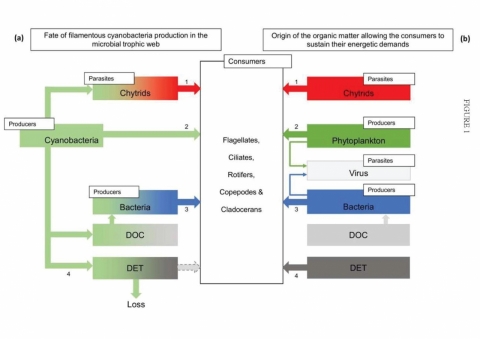
Microbial parasites make cyanobacteria blooms less of a trophic dead-end than commonly assumed. Matilda Haraldsson, Mélanie Gerphagnon, Pauline Bazin, Jonathan Colombet, Samuele Tecchio, Télesphore Sime-Ngando, Nathalie Niquil. The ISME Journal 12, 1008-1020 (2018). doi: 10.1038/s41396-018-0045-9
Parasites exist in every ecosystem and can have large influence on food-web structure and function, yet, we know little about parasites’ effect on food-web dynamics. Here we investigate the role of microbial parasitism (viruses of bacteria, phytoplankton and cyanobacteria, and parasitic chytrids on cyanobacteria) on the dynamics of trophic pathways and food-web functioning during a cyanobacteria bloom, using linear inverse food-web modeling parameterized with a 2-month long dataset (biomasses, infection parameters, etc.). We show the importance of grazing on heterotrophic bacteria (the microbial pathway: DOC -> bacteria -> consumer) and how consumers depended on bacteria during peak-cyanobacteria bloom, which abundance was partly driven by the viral activity. As bacteria become the main energy pathway to the consumers, the system takes a more web-like structure through increased omnivory, and may thereby facilitate the system’s persistence to the cyanobacteria outbreak. We also showed how the killing of cyanobacteria host-cells by chytrids had important impact on the food-web dynamics by facilitating grazing on the cyanobacteria, and by offering alternative pathways to the consumers. This seemed to increase the system’s ability to return to a mix of trophic pathways, which theoretically increases the stability of the system.
BOREA contact : Matilda Haraldsson, matildaharaldsson@gmail.com
